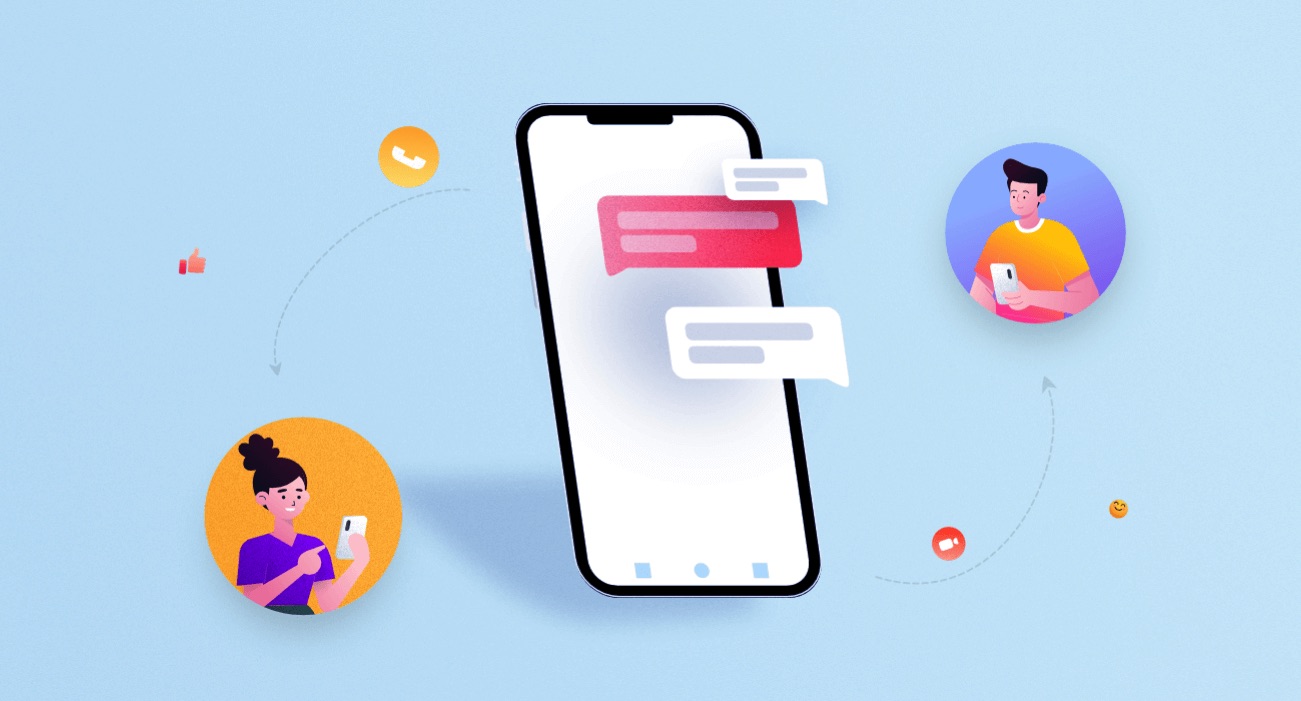It is estimated that by 2026, 90% of online content will be AI-generated or manipulated. With robots taking the internet by storm, the need for genuine, human-centric marketing is more pressing than ever.
That’s where people based marketing comes into play, offering a refreshing shift from automated or search-engine-driven strategies to truly human-centric campaigns that focus on authentic, meaningful connections. This approach isn’t just another trend— it’s a revolution in how we engage with customers, fostering deeper emotional connections, trust, and loyalty.
The Essence of People Based Marketing
People based marketing focuses on creating genuine connections by understanding and addressing the unique needs and emotions of individuals. Unlike traditional marketing, which often relies on broad demographics and generalized messaging, people based marketing leverages target customer data and research to craft personalized experiences that resonate on a personal level.
Practical Tip: Use customer feedback and data analytics to understand your audience’s preferences and pain points. Tailor your marketing messages to address these specific needs. For instance, if your customers frequently mention the need for faster service, highlight any improvements or strategies you’ve implemented to address this.
Benefits of People First Marketing
- Improved Customer Engagement: By addressing individual needs and preferences, people first marketing significantly enhances customer engagement. Personalized interactions make customers feel valued and understood, leading to stronger emotional connections and relationships.
- Personalized Experiences: Tailoring marketing efforts to individual preferences results in more relevant and impactful experiences. This not only boosts customer satisfaction but also drives higher conversion rates. In fact, 91% of consumers say they are more likely to shop with brands that recognize, remember, and provide relevant offers and recommendations.
- Higher Conversion Rates: When marketing messages are aligned with the specific needs and desires of customers, the likelihood of conversion increases. People first marketing helps in crafting compelling offers that are hard to resist. Nearly 60% of shoppers who have experienced personalization believe it played a role in their final purchase decision.

AI Marketing vs. People Marketing
While AI-driven marketing offers precision and efficiency, it often lacks the human touch necessary for building authentic connections. AI can analyze vast amounts of data and automate tasks, but it cannot replicate the empathy and understanding that human marketers bring to the table. For example, an AI might recommend products based on browsing history, but a human marketer can craft a heartfelt thank-you note for a loyal customer. People marketing, on the other hand, prioritizes human insights and emotions, leading to more meaningful interactions and long-term customer loyalty.
People First vs Search Engine First Content
Creating content with a people-first approach means prioritizing the needs and interests of your audience over merely optimizing for search engines. According to Google’s guidelines for creating helpful content, content should be made primarily for users, not search engines. This approach ensures that your content provides real value, fosters trust, and meets the needs of your audience. “We recommend that you focus on creating people-first content to be successful with Google Search, rather than search engine-first content made primarily to gain search engine rankings,” state Google’s content guidelines.
Focusing on people-first content means avoiding practices like creating content solely to attract search engine traffic, using extensive automation, or summarizing what others have said without adding value. Instead, aim to provide in-depth, original content that addresses the real needs of your audience.
Interestingly, because Google is actively looking for and rewarding this type of content, focusing on creating valuable, user-centric content can also benefit you from an SEO standpoint. By prioritizing people over search engines, you are more likely to see improvements in your search engine rankings as your content aligns with what Google deems most helpful and relevant.
The Importance of People First Content
Creating content that prioritizes people involves understanding their needs, desires, and pain points. Here are some tips for crafting compelling, human-centric messages:
- Know Your Audience: Conduct thorough research to understand your audience’s demographics, interests, and behaviors. Use tools like surveys, social media polls, and analytics to gather data.
- Be Authentic: Authenticity is key. Avoid generic messages and focus on being genuine and transparent. Check out this blog post for more on authentic marketing.
- Tell a Story: People connect with stories. Craft narratives that resonate emotionally and highlight real-life experiences. For more on effective storytelling, check out our StoryBrand Brandscript guide.
- Engage Emotionally: Tap into emotions to create content that moves and inspires your audience. Use vivid imagery and relatable scenarios to connect on a deeper level.
Implementing People Based Marketing Solutions
Implementing people based marketing involves several key steps. Here’s how to dive deeper and create a truly customer-centric strategy:
- Conduct Customer Research
- Surveys and Interviews: Use surveys and one-on-one interviews to gather detailed insights about your customers’ preferences, challenges, and expectations.
- Social Listening: Monitor social media platforms to understand what customers are saying about your brand and your competitors.
- Reading Testimonials and Complaints: Analyze customer reviews, testimonials, and complaints to identify common themes and areas for improvement.
- Create Ideal Customer Profiles
- Develop Personas: Based on your research, create detailed personas that represent different segments of your audience. Include information about their demographics, behaviors, goals, and pain points.
- Tailor Content and Messaging: Use these personas to guide your content creation and marketing messages, ensuring they resonate with each specific segment. For expert assistance in crafting these messages, explore Flyrise’s brand messaging services.
- Customer Segmentation
- Behavioral Segmentation: Divide your audience based on their behaviors, such as purchase history, website interactions, and engagement levels.
- Demographic Segmentation: Segment your audience based on demographics like age, gender, income level, and location.
- Psychographic Segmentation: Consider customers’ lifestyles, values, and interests to create more personalized marketing strategies.
- Personalized Content
- Tailor Messaging: Create content that speaks directly to the needs and interests of each segment. Use personalized email campaigns, targeted social media ads, and customized website experiences.
- Utilize Dynamic Content: Implement dynamic content on your website and emails that changes based on the visitor’s profile and behavior.
- Data-Driven Insights
- Analytics Tools: Use analytics tools to track customer behavior and preferences. Analyze data to understand which strategies are working and where there’s room for improvement.
- A/B Testing: Conduct A/B tests to determine the most effective content, design, and calls to action for different segments.
- Continuous Optimization
- Regular Reviews: Schedule regular reviews of your marketing strategies and content. Use customer feedback and performance metrics to make informed adjustments.
- Iterative Improvements: Continuously refine your personas, segmentation strategies, and content to better meet the evolving needs of your audience.
People-Based Marketing Strategies for Different Industries
Here are some industry-specific strategies to implement people based marketing effectively. Remember, these are just starting points. The essence of people based marketing is to truly connect with your audience on a personal level, so tailor these strategies to the unique needs and preferences of your customers.
- Retail
- Personalized Shopping Experiences: Use customer data to personalize shopping experiences both online and in-store. Offer product recommendations based on previous purchases and browsing history.
- Loyalty Programs: Develop loyalty programs that reward customers for their repeat business and engagement. Personalize rewards based on individual customer preferences and behaviors.
- Customer Feedback: Regularly collect and analyze customer feedback to refine and improve the shopping experience.
- Healthcare
- Patient-Centric Communication: Develop communication strategies that address the specific needs and concerns of different patient groups. Use personalized emails and text messages to remind patients of appointments and follow-up care.
- Educational Content: Create and share educational content that addresses the unique health concerns of your patient demographics. Use blog posts, videos, and social media to provide valuable information and build trust.
- Support Groups: Establish support groups for patients with similar conditions to foster a sense of community and shared understanding.
- Hospitality
- Customized Experiences: Personalize guest experiences by offering tailored recommendations for activities, dining, and services based on their preferences and past stays.
- Feedback and Improvement: Encourage guests to provide feedback and use this information to continually improve and personalize their experiences.
- Special Offers: Create special offers and packages based on guest preferences and past behaviors to enhance their stay.
- Finance
- Personal Financial Advice: Provide personalized financial advice and solutions based on individual customer data. Use targeted content to address specific financial goals and challenges.
- Transparent Communication: Build trust by being transparent about fees, terms, and conditions. Use clear and honest communication to explain financial products and services.
- Financial Education: Offer educational resources to help customers make informed financial decisions.
- Education
- Tailored Learning Paths: Use data to create personalized learning paths for students. Offer customized content and resources to support their individual learning needs.
- Engagement and Support: Develop communication strategies that keep students and parents engaged and informed. Use personalized messages to provide support and address concerns.
- Student Feedback: Collect and use student feedback to continuously improve educational programs and materials.
- Technology
- User-Centric Design: Design products and services with the end-user in mind. Gather feedback and use it to improve the user experience continuously.
- Support and Onboarding: Provide personalized onboarding experiences for new users. Offer tailored support and resources to help them get the most out of your products.
- Community Building: Foster a community of users who can share tips, provide feedback, and support each other.

Embrace People Based Marketing with Flyrise!
People based marketing is so much more than a strategy or a trend— it’s a philosophy that places the customer at the heart of everything. By adopting this mindset, businesses can foster deeper connections, enhance customer loyalty, and drive more sustainable growth.
Ready to connect with your customers on a deeper (more human) level? Schedule a free strategy session with Flyrise.



